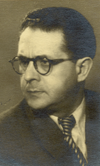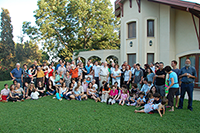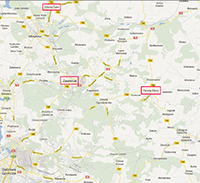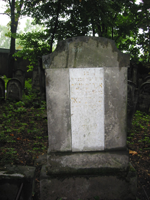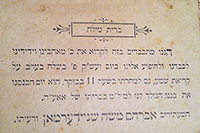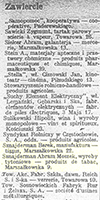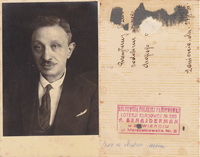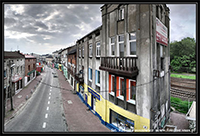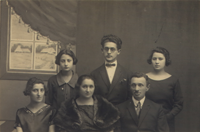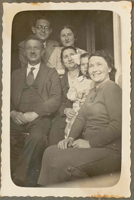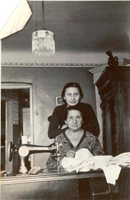The Story of Abraham Moshe and the Town of Pilica
WhatsNew:
Release October 16, 2022
Yigal used to write short chapters and read them at various events in the nursing home where he lived in the last years of his life.
The large and interesting part of the chapters are part of his life history.
Few are translations or abridgments of facts related to general education.
Release Feb 23, 2020
Berek Szczekacz and Chana Szmidt
Berek Szczekacz and Chana Szmidt had 12 children. Searching for Birth, Marriage, Death records (BMD) brings us occasionally to meet living family members. I admit, getting to know new blood related family members is the most exciting part of doing genealogy. Lately I met Yoram Shachar, one of Berek and Chana’s great, greatgrandchild about whom I haven’t heard until Dec 15, 2019. The meeting has prompted me to create pages for the descendants of Berek Szczekacz, our mutual great, great grandfather. The released page will introduce you to the 12 children and to their children. Currently there are only two documented stories, about Layzer Ludwig Szczekacz and about Frajdla Szczekacz. The stories about Yoram Shachar, Samuel Szczekacz (The artist, Shmuel Tzur), the many Shakter’s descendants and others will follow soon.
Release Nov 9, 2019
Yosef Kaluzynski and Chana nee Sznajderman
Release Jan 6, 2018
Fajgla Kaluzynski and Wolf Szperling

The Holocaust Had no Mercy for the Szperling Family
Stories and Photos
Release June 26, 20
A Telephone call from Australia to Californiaswept Jane and me into a research in the Czech Republic. Several families appeared for a moment and then disappeared during the Holocaust. Very few suvivors, many Yad Vashem testimony pages and research in the Czech Republic declared Jane, Dov Kuflik, his sister, Idit, and the five grandchildren of Josef Arieli, my self included, are 3rd cousins. Jane, Dov and his sister, Idit, are 2nd cousins.
Dawid Borejdo Sznajderman
The following story is about Dawid Sznajderman, the son of Abram Moshe Sznajderman and Ajdla Koenigsberg, who survived the tumultuous time of WWII.
Marek Kaluzynski was son of my great grandfather, Abram Kaluzynski, and his second wife, Chaja Dzialoszynska.
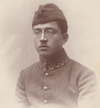
Marek’s mother, Chaja, died around 1912 in Czestochowa, leaving his father with five young children;
the youngest, Sara, was two years old. Marek was fourteen years old.
Release History
Important Links
Read the Beautiful translation by Jerrold Landau
Connect with Czestochowers all over the wold.
The World Society of
Czestochowa Jews
And Their Descendants
Family History
Memories, like sand stones
Slowly, a grain follows a grain,
Erode, crumble, and vanish.
Sea waves and wind
Sweep them away
Hurry
Listen to the voices
Collect the words,
The names, the episodes, the moments…
Carve and seal them
In a meticulously crafted pendant
Close to your heart
Allow them to live forever.
Let Us Start With Basic Steps:
Write down everything you know about yourself and about your family:
- Full names
- Date of Birth, Marriage and Death
- Where these events occured
- Talk to your grandparents, parents, uncles and aunts
- Write down family anecdotes
- Scan family photos
- Scan Family documents
The Story of Abraham Moshe and the Town of Pilica
-
Sznajderman Community in Israel
-
Family Origin: Pilica And Zawiercie
-
Pilica Records
-
Pilica History, V'ad Arba Artsot, and Shabtai Tzvi
-
Abraham Moshe Sznajderman
-
Abraham Moshe Sznajderman Business
-
Abraham Moshe Sznajderman and his Family
-
Ajdla Sznajderman nee Koenigsberg
-
Pilica, WWII
-
Zawiercie, WWII
-
End of the Story
-
Acknowledgment
|
- 1 - Sznajderman Community in IsraelIn 2007, I spent some of the summer in Israel and stayed at my home in the village of Bnei Zion. Our backyard lawn was green and inviting, and I was full of energy. I decided it was the right place for sharing my obsession with genealogy with my extended family. On one Saturday bright afternoon I invited all my Sznajderman relatives to our garden. Sznajderman family gatherings are always fun. ‘Sznajderman’ is almost synonymous with the words ‘pleasant’ or ‘being nice’. Family members came over from all over the country for this special reunion. Among the guests there was a newborn - a one-week-old baby - and 95-year-old uncles. There was plenty of food. There was a family tree diagram pasted on the wall, complete with pencils alongside for viewers to add and correct the data. And of course there was a lot of squeezing and maneuvering to get all of us into one clear photo. It was an enjoyable afternoon for everyone. |
- 2 - Sznajderman Family - Bnei Zion Israel, 2007
|
- 3 - Sznajderman Family - Bnei Zion Israel, 2007 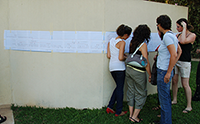
|
top |
|---|
|
- 4 - Family Origin: Pilica And ZawiercieMy grandmother was Chana Kaluzynski nee Sznajderman. Her father, Eliezer Sznajderma and his siblings, and her eldest brother, Abraham Moshe, were all born in the town of Pilica. My grandmother, along with six of her eight siblings, Wolf, Sima, Shlomo, Dawid, Ryfka and Israel were born in Zawiercie, Poland between 1879 and 1890. Zawiercie and Pilica are 10 miles apart as you will see in the map.
|
- 5 - Chana Kaluzynski nee Sznajderman 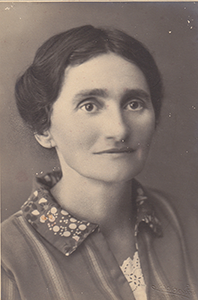
Unfortunately, when I visited Poland with my husband and my sister Ora in 2002, I was only beginning to research my family roots. I had never heard of Pilica and had no knowledge of our family ties to the town; as a result, we didn’t stop there. It was only later when I had delved deeper into research and collected more records from Polish archives that I traced the origins of the Sznajderman family back to Pilica. |
- 6 - Dawid and Shlomo Sznajderman with the Hampel Family in Poland 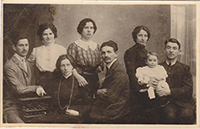 |
|
- 7 - Rywka Sznajderman
|
- 8 - Israel Sznajderman and his wife Shendel Markowitz 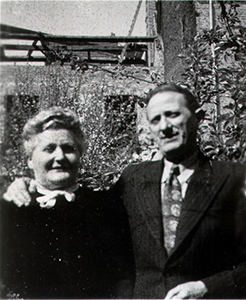
|
- 9 - Several members of the Sznajderman family were laid to rest in the cemetery at Zawiercie: My grandmother’s parents, Eliezer Sznajderman and Eygda Sznajderman, her eldest brother, Abraham Moshe Sznajderman, her uncle, Isachar Dov Sznajderman, and the wife, Rachel Bayla, of her uncle Mordka Leyb Sznajderman.
<
|
|
- 10 -
Eygda Sznajderman, daughter of Mordechai Aharon, wife of Eliezer Sznajderman, died in 1913. |
- 11 -
Abraham Moshe Sznajderman |
- 12 -
Isachar Dov Sznajderman, |
top |
|---|
|
- 13 - Pilica RecordsOur Sznajderman ancestors can be traced back to the 18th century in Pilica, Poland. I have identified Marek Sznajderman who was living in Pilica by 1819 and possibly even before that. Marek Sznajderman was born about 1778. His birth and marriage places are still elusive as of now. He died in Pilica at the age of 75 on the 28 August 1853. The earliest existing birth, marriage and death records (BMD records) for Pilica’s Jewish population are from 1808, and there is no record there for Marek’s birth or marriage. I searched the 1792 census for Pilica, but couldn’t find either his name or his wife, Rochla, in the list.
|
- 14 - Marek Sznajderman, my 3rd great grandfather
|
- 15 - Pilica History, V'ad Arba Artsot, and Shabtai TzviIn my search for articles and books about the history of Pilica and its Jewish community, I found some interesting facts that fascinated me as history per se. These facts also provided explanations for why many families left Pilica at the end of the 19th century. The following is my attempt to weave together some historic facts about Pilica prior to WWI with the few facts I know about the life of my grandmother’s eldest brother, Abraham Moshe Sznajderman. |
top |
|---|
|
- 16 - The Wolbrom Yizkor book, tells about the V’ad Arba Aratsot conference: When I read the last paragraph and compare it with the facts in Sznajderman family tree I cannot but conclude that the Sznajderman families were among those who were affected either by the fire or the deteriorating economic situation and forced to move to Zawiercie.
|
- 17 - Abraham Moshe Sznajderman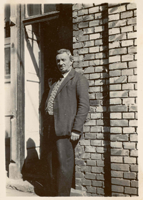
Abraham Moshe Sznajderman was my grandmother’s eldest brother and the only one among her siblings to be born in Pilica. His mother, Eygda Sznajderman nee Sztatler, named him after her grandfather Abraham Sztatler who died on 3 November 1865 in Olkusz, Poland.
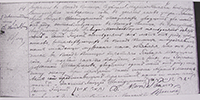 Abraham Moshe Sznajderman's Birth Record
Birth Record Translation:
|
- 18 -
Abram Moshe Sznajderman had seven brothers and sisters: Wolf died when he was one month old. Chana, Dawid and Szlomo immigrated to Israel at about 1906, and lived, raised children and died in Israel. Their life story is the story of the foundation of Israel and will be told in separate pages. Another sister, Ryfka Sznajderman, immigrated to Israel at a later date, with her son Chanan Paisak. The brother, Israel, joined his Zionist siblings around 1910, but returned back to Poland and spent WWII in hiding in Holland. Yet, another sister, Sima, married Icyk Borenblat from Kielce, in 1897 when she was nineteen years old. Her marriage record is the only fact the archival records show about her. Sima and her husband don’t appear in the 1906 family photo of Eliezer and Eigda Sznajderman in Zawiercie and didn’t leave us any other photograph or document. A request I sent to the ITS didn’t reveal any details about the fate of Sima and Icyk Borenblat. They seem to have disappeared from the family horizons even before WWI. 
Eliezer and Ejgda Sznajderman Family around 1910, in Zawiercie or Bedzin
Abraham Moshe didn’t join his siblings’ quest to explore life outside Poland, but stayed in Poland and wandered from one shtetl to another until his death in 1938 in Zawiercie. The wanderer Jew. |
top |
|---|
|
- 22 - Abraham Moshe BusinessAfter the birth of Idessa and Gitla the family moved again to Zawiercie where Abraham Moshe’s parents already lived. According to Zawiercie’s 1926-27 and 1929 business directories, Abraham Moshe had a tobacco shop in Zawiercie on Marszalkowska 9 and another business: Zawiercie 1929Business Directory
A photo of Abraham Moshe shows a permit to sell lottery tickets on Maszalkowska Street Number 2.
|
- 23 - When searching the Zawiercie business directories in the years 1926-1929 we find out that most of the Jewish Business were located on Marszalkowska Road. The synagogue was on Marszalkowska 42. On Marszalkowska 9 there were two other Jewish shops:
As a side note, one of the shops on Marszalkowska 9 today, 2012, is a shop displaying the name "Tribal Tattoo and Piercing ."
Marszalkowska Street, 2012 |
- 24 - There are minor hints that Abraham Moshe’s business was doing relatively well: Searching the site provided a list that includes people from Zawiercie, among them Abraham Moshe Sznajderman: list of Zawiercie residents who purchased assets The assets can be located by following the instructions at the site and proving the relationship of the person who makes the request to Abraham Moshe Sznajderman. There is an additional hint of Abraham Moshe Sznajderman relative financial stability. It is in Kromolow’s List of Fees, Synagogue District of Kromolow for 1908. The file was found in Katowice Archives, syg. 887/176 and includes 419 persons from the town (Kromolow is the oldest town of Zawiercie was founded.) The list is about a community tax, a fee which the wealthier Jews paid to the community. The community tax was not a large sum since its uses were not too large. One needn’t to be really rich in order to be asked for the fee.
|
top |
|---|
|
- 25 - Abraham Moshe Sznajderman and his Family
In the family photo above, sitting in the center are Abraham Moshe and his wife, Ajdla Keoningsberg. Dawid Sznajderman, their eldest son, is standing behind them. Mordka the youngest son is absent in the photo. Maybe the photo was taken when Mordka or Maurice, had already left for Austria. Dawid and Mordka stories will appear in separate chapters. On the left, there are two girls. One is sitting and her sister standing behind her. I think they are Idessa (sitting) and Gitla. Who is the good-looking young woman on the left? She appears in other photos and it is a riddle that has yet to be solved. Did Abraham Moshe have three girls? My father visited Poland in 1937. His story appears on another page. He brought with him several photos of Abraham Moshe and his immediate family. See the page about Ariel's visit the family in Poland. Abraham Moshe died on 26 Feb 1938 and was buried in Zawiercie alongside his parents and two other Sznajderman family members: his uncle, Isachar Dov, son of Yizchak Yekutiel Sznajderman, who is the brother of our great grandfather Eliezer, and another grave of Rachel Bajla Sznajderman whose link to the tree I haven’t discovered yet.
Sitting: Left to Right: Abraham Moshe, his wife Adela Koenigsberg, grand daughter Irene and ?. Standing: Dawid Sznajderman and his wife, Fela Perlmuter. |
- 26 - Ajdla Sznajderman nee KoenigsbergAbraham Sznajderman’s wife was Ajdla Sznajderman. At the beginning of WWII she was a widow. Her children were scattered in Poland, France and Mexico, and I assume that she herself lived in Zawiercie. It touched my heart that Beatrice Sznajderman, who was born immediately after WWII in France and raised there, and Adela Perla, who grew up in Mexico, both remembered to add a page of testimony for their grandmother. Beatrice’s father, Maurice or Mordka, and Adela’s grandmother, Idessa or Judith, were brother and sister. The granddaughters grew up on different continents of the world. They never met and I think that to this day they don’t know about the each other. Again the wandering Jew. Adela Perla was named after her great grandmother, Adela Sznajderman nee Koenigsberg. I wonder what was it about the mother, Adela, that her children remembered to pass along to their children. They certainly commemorated her by naming their daughters in her honor and fostered the respect both granddaughters showed in adding a testimony page for her while visiting Yad Vashem.
Adela Sznajderman nee Koenigsberg, wife of Abraham Moshe and her daughter Judith. |
- 27 - Ajdla Sznajderman had two more granddaughters in Paris, Mordka’s daughters: Jeanine, born in 1930 and Regina, born in 1933. Her daughter Judith lived in Mexico before WWII and had two sons before WWII, Yitzhak born in 1929 and Benito born in 1937. Did she ever meet them? Did Maurice and Judith send letters with photos of their children?
Pilica, WWIISome information about the Jewish community in Pilica in later years up to WWII can be found in the following sites: The Town of Pilica During the WWII Pilica - in the International Cemetery Project Sonia Pressman Fuentes Visit the Town of Pilica During the Second World War, the town of Pilica was occupied by the German army in September 1939. The Germans created a ghetto where 2,000 Jews were sent.
Pilica, Poland - Synagogue Copyright © 2011 Yad Vashem |
top |
|---|
|
- 28 - Zawiercie, WWIIIn 1939 there were approximately 7,000 Jews in Zawiercie. On September 2, 1939 about 2,000 of them fled as German troops occupied the city. During the first days of the occupation all Jewish males between the ages of 17 and 50 were ordered to assemble in the market square. They were detained and tortured for nine days before being released. A formal ghetto was established in Zawiercie in the summer of 1940. That fall about 500 young Jews were deported to labor camps in Germany. In a deportation action that took place in May 1942 approximately 2,000 Jews were sent to Auschwitz. The ghetto was finally liquidated on August 26, 1943, when most of the remaining Jews were deported to Auschwitz. During the deportation action 100 Jews were shot on the spot. The 500 remaining Jews were kept at the newly established Zawiercie labor camp, which was subsequently liquidated on October 17, 1943. The data about Zawiercie Ghetto was extracted from
|
- 29- End of the StoryGenealogy research almost always leads to a sad ending. One reaches the Holocaust years and most of the family members perish. The history for the Sznajderman branch of Eliezer Sznajderman turned out to be brighter. Most of Eliezer’s children left Poland before WWI and began new lives in Israel, France, Germany and the USA. As you see at the opening of the story, the family in Israel grew and continued to stay together. |
- 30 - Acknowledgment I thank my cousin Tolek Sznajderman who shared my enthusiasm for researching our family roots, but unfortunately passed away suddenly. |
top |
|---|
